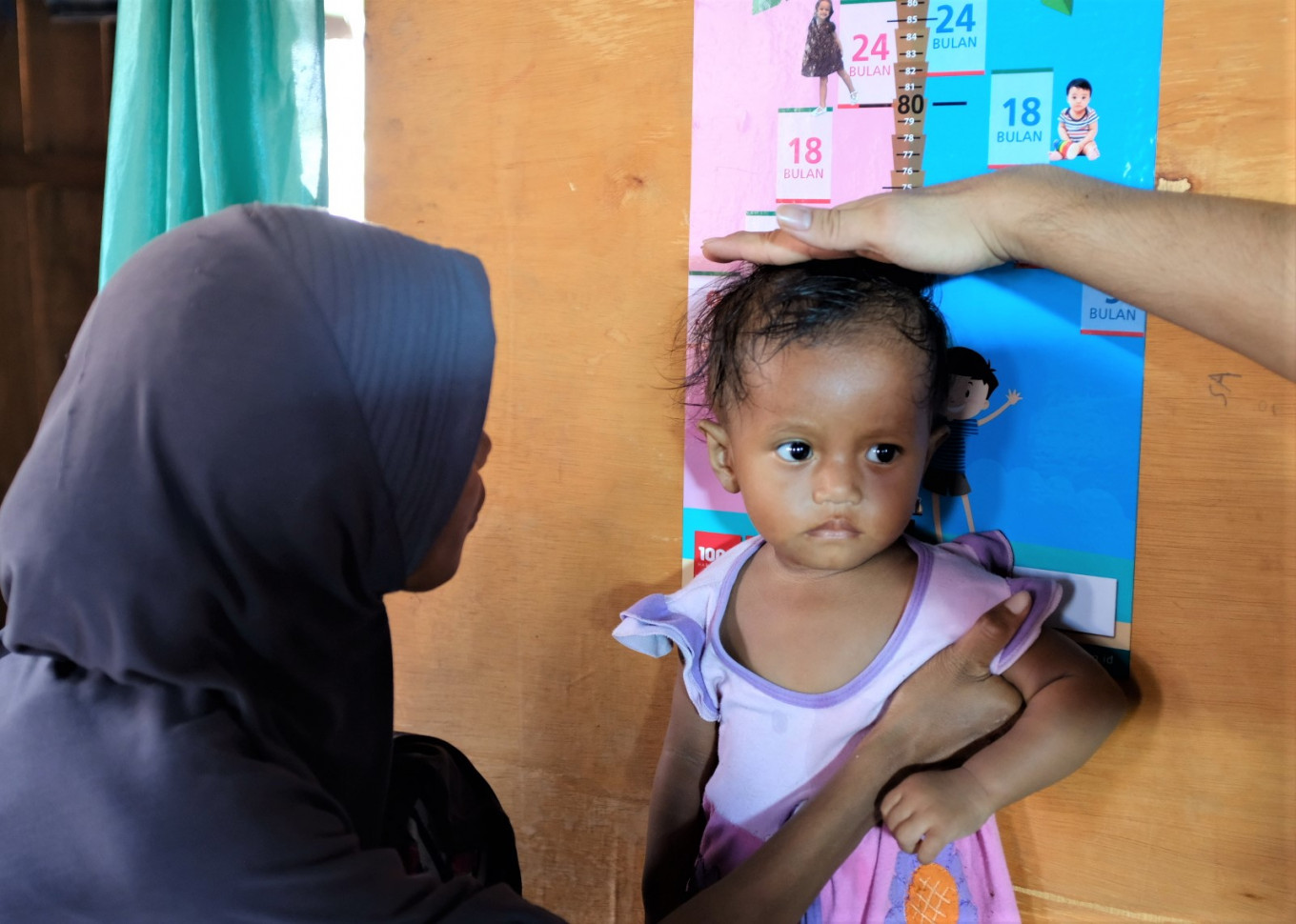Popular Reads
Top Results
Can't find what you're looking for?
View all search resultsPopular Reads
Top Results
Can't find what you're looking for?
View all search resultsStunting in Indonesia: Winning the battle but losing the war?
An unbridled optimism about the eradication of stunting within the next 10 years is potentially dangerous, for a few reasons.
Change text size
Gift Premium Articles
to Anyone
A
bout 27.7 percent (1 out of 4) Indonesian children under 5 years of age remain stunted, despite massive efforts by the government. This figure from the Health Ministry’s 2019 Basic Health Survey (Riskedas) indicates an improvement from the 2018 national average of 31.8 percent. But with a stunting prevalence of 42.6 percent, East Nusa Tenggara (NTT) — one of the archipelago’s most deprived and neglected regions — is perhaps a better gauge of the nation’s success, if not trials and tribulations, in its ongoing battle against this scourge.
Stunting, a term that conjures up images of film doubles engaged in death-defying moves, actually refers to a condition where undernourished children suffer reduced growth of body and brain. The more conspicuous sign is a shorter stature or low height for age, or a low weight for age in the case of extreme undernourishment, a condition called wasting. Less apparent, though more serious, is the deleterious effect on the nervous system, impairing cognitive and learning abilities.
Stunted and wasted children are inexorably condemned to a life of protracted pain and suffering, if they manage to avoid a premature death. A weakened immune system exposes them to a litany of diseases such as diarrhea and pneumonia. A compromised brain drastically lowers their academic achievement.
Further hurdles await them later in adult life in the form of chronic diseases such as diabetes, hypertension, coronary heart disease and obesity, lowering their productivity and earnings potential, and putting them at a greater risk of extreme poverty.
Indeed, the estimated 10.5 percent gross domestic product loss to the Indonesian economy as a result of unachieved productivity and development is nothing short of an exaggeration.
Over the years, the Health Ministry has delivered a host of anti-stunting programs. The bulk of these programs consists of nutritional correction among mothers in the form of iron tablets (against anemia) while they are expecting, with micronutrient supplementation after they give birth until the child is 2 years of age (1,000 days).
The ministry has also actively promoted best practices related to breastfeeding, complementary feeding, therapeutic feeding and basic hygiene. Undoubtedly, these large-scale measures have been effective. From 2007 to 2013, the nationwide stunting rate for children below 5 hovered around 37.2 percent (9.5 million children). This figure was first reduced to 30.5 percent in 2018 and then to 27.7 percent in 2019 — a downward trend suggesting that Indonesia is on course to achieve its noble but ambitious goal of eradicating stunting in 2030.
The government needs to be applauded for its Herculean efforts to reach out to nearly 268 million people scattered across 17,508 islands. However, an unbridled optimism about the eradication of stunting within the next 10 years is potentially dangerous, for a few reasons.
First, the overwhelming focus revolves around the first 1,000 days of a child’s life (from conception until the age of 2). Thus, it targets only expectant and lactating mothers; it ignores the larger number of potential victims, especially undernourished girls above two years of age who passed the height and weight tests but are still at risk of becoming stunted.
Stunted girls eventually end up as stunted mothers giving birth to stunted children, perpetuating a vicious cycle. A better, albeit more costly, approach to solve — not simply mitigate — the problem would be to intervene on all age groups over a certain period of time once a population at risk of stunting has been identified.
Admittedly, a task of this magnitude is beyond any government and cannot be achieved without the assistance of civil society and the private sector.
Second, the strategy of keeping highly stunted communities on life support through constant food and supplement donations is risky and unsustainable. Such programs are at the mercy of budget allocations, with funding ruthlessly slashed when economic downturns force regencies to reassess their priorities. Indeed, a better strategy would be to invest in agriculture and empower vulnerable communities to attain self-sufficiency in affordable nutritious food. In this regard,
Lao Tze, a Chinese philosopher, has some valuable advice: “Give a man a fish and he’ll eat for a day; teach him to fish and you feed him for a lifetime.” However, metaphorically, most poverty-stricken communities with high stunting numbers in Indonesia do know how and where to fish. What they lack is a fishing rod and access to unpolluted fishing waters.
Literally, to encourage fishing wouldn’t be a bad idea either; freshwater fish farming provides a cheap, steady and valuable source of animal protein.
Third, the modus operandi blatantly overlooks the broader context to which both the mother and child are exposed. For instance, staple and high nutrient foods are exceptionally expensive in Indonesia. This is due to long-standing policies and under-investment in agriculture and infrastructure.
A “Cost of Diet Study” conducted in 2017 reveals that 38 percent of the whole population cannot afford a staple-adjusted nutritious diet. In NTT, this figure jumps to 78 percent. In the absence of food gardens at home, at school, or on communal lands, people have to buy all their food at high cost.
This situation is further aggravated by the ubiquitous availability and relentless advertising of unhealthy but affordable ultra-processed food and sweetened beverages that fill but kill. The problem is compounded by the government’s stifling inertia and disappointingly lackluster campaigns in promoting the benefits of a healthy diet.
So far, public health policies have focused on large-scale yet short-term measures that cure the effects of stunting rather than prevent it; billions of dollars are spent every year in fixing problems we could have avoided in the first place. What is badly needed is a paradigm shift that emphasizes prevention rather than cure, plus a political will to see it through the long term.
The solution, it seems, lies far beyond measuring tapes and weighing scales.
***
Learning and development director at BIJAK (Bringing Improved Judgement, Awareness and Knowledge), an independent nonprofit organization that empowers children, youth and adults










